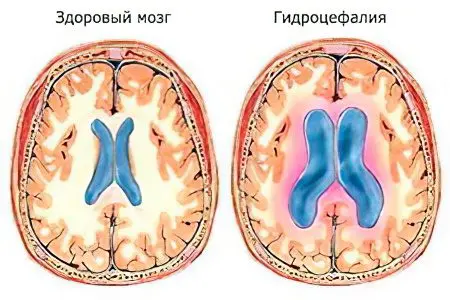Contents
The diagnosis of “intracranial pressure” in a newborn baby, made by a pediatric neurologist, confuses the child’s parents. They do not know what can be done in this case, and, most importantly, what consequences this pathology can give to the health of the baby.
What does increased intracranial pressure mean?

It is much easier to navigate the features of the pathology, knowing the anatomy of the brain. The brain is protected by several membranes, the space between which is filled with cerebrospinal fluid. The system of interconnected ventricles is filled with the same fluid, which, together with the membranes of the brain, creates a kind of protection against possible injuries and concussion.
If the volume of cerebrospinal fluid exceeds the allowable rate, it puts pressure on the structures of the brain. Increased intracranial pressure leads to negative consequences and sensations.
Is an increase in intracranial pressure always a pathology? Intracranial pressure in a child can briefly increase during coughing, stress, crying, during bowel movements, while sucking at the breast during feeding. Everyday episodic pressure surges are not at all dangerous for the child, however, if this symptom is permanent, examination and treatment of the pathology is required.
High intracranial pressure – a diagnosis or a symptom? This is not a separate disease, but a symptom of a violation of the functioning of individual systems and organs of the child’s body. A detailed diagnostic examination will help identify the underlying disease that affects the formation of a persistent rise in pressure.
Causes of increased intracranial pressure

Diseases accompanied by increased intracranial pressure:
Brain tumors of any etiology – changes in brain structures and a growing tumor put pressure on its tissues;
Meningitis – a change in the properties of the cerebrospinal fluid towards viscosity leads to a violation of its outflow and the formation of cerebral edema;
Encephalitis – an inflammatory process in the cerebral cortex leads to swelling of its tissues;
Toxic damage – leads to edema;
Hydrocephalus – a violation of the outflow of cerebrospinal fluid along the cerebrospinal fluid pathways with this pathology is impaired, exceeding the permissible volume of cerebrospinal fluid leads to an increase in pressure;
Genetically determined congenital pathologies of the functioning of the brain;
Traumatic brain injury – edema as a result of a brain contusion, the possible formation of a subdural hematoma provokes an increase in the volume of brain tissue;
Hemorrhage in the structures of the brain – the focus of hemorrhage occupies a certain volume and compresses nearby tissues;
Cerebral edema is a consequence of intrauterine fetal hypoxia or hypoxia during childbirth;
Too fast closing of the “fontanelle” – earlier fusion of the bones of the skull with a growing brain leads to a gradual increase in pressure.
Symptoms of intracranial pressure in children

A variety of symptoms of high blood pressure can be supplemented by symptoms of the underlying disease that provoked the pathology. The main factor – dividing the signs of pressure into groups – is the age of the child, because the presence or absence of “fontanelles” on the baby’s skull is of great importance. Finally, the bones of the skull usually do not fuse up to a year, after a year the “fontanelles” are already closed. This factor directly affects the manifestations of pathology.
Symptoms in young children
It is difficult for an infant to make a diagnosis, you have to rely on visual signs:
Anxiety behavior, tearfulness. Usually a child with intracranial hypertension is calm during the day, and in the evening and at night he worries, cries and is naughty. This is due to the fact that when the baby is in a horizontal position, the outflow of cerebrospinal fluid is slowed down, the veins are full, which leads to an increase in the volume of cerebrospinal fluid and its pressure on the brain.
Sleep disturbances, restless sleep, difficulty laying down. The reason for this behavior is similar to the factors described above.
Regurgitation, nausea, vomiting. This symptom may be physiologically justified, because swallowing air during suckling or overfeeding can cause such manifestations. Meanwhile, such symptoms may well appear due to irritation of the structures of the medulla oblongata, as a result of increased intracranial pressure.
Enlargement of the skull. As a result of hydrocephalus, which occurs due to the accumulation of cerebrospinal fluid in the cavities of the brain, “fontanelles” swell, the bones of the skull diverge, its frontal part increases, and the child’s head becomes disproportionate in size.
Clearly visible venous network under the scalp. Excessive expansion of the saphenous veins due to stagnation of blood and excessive filling of the venous network with it, makes the veins visible.
Graefe’s symptom
It is expressed in uncontrolled downward movements of the eyeballs, when a strip of sclera is visible between the iris and the upper eyelid. The sign is called the “symptom of the setting sun”, manifested as a result of disruption of the oculomotor nerves due to intracranial hypertension or birth trauma.
Refusal to eat. Sucking movements increase the already increased intracranial pressure, which leads to negative sensations in the child. The pain is so severe that the child refuses to eat and loses weight.
Delayed psycho-emotional and physical development. The symptom occurs due to the negative impact of pathology on the baby’s body and lack of nutrients.
Symptoms in older children

Nausea and vomiting due to irritation of the structures of the medulla oblongata with an excessive amount of cerebrospinal fluid, vomiting does not bring relief;
Pain behind the eyeballs due to the pressure of the cerebrospinal fluid on the eye socket area;
Complaints of children about double vision, the appearance of flashes and ribbons before the eyes, arising from irritation of the optic nerves;
Headaches of high intensity, increasing in the evening and at night;
Sleep disturbances, anxiety;
Behavioral disturbances – tearfulness, irritability.
Complications and consequences
If hypertension is not treated, the following complications may occur:
Violations of mental development, its delay;
Development of an epileptic syndrome;
Deterioration of vision;
Development of ischemic or hemorrhagic stroke;
Disorder of consciousness, impaired respiratory activity, a feeling of weakness in the arms and legs due to infringement of the cerebellum.
Diagnosis of intracranial pressure

To determine the correspondence between the norm and pathological excess of intracranial hypertension, spinal puncture was previously used – an invasive method, which is associated with complications. Currently, there are many alternative diagnostic methods.
At the beginning of the examination, you need to visit a pediatric neurologist to determine the deviation in the formation of reflexes, the size of the baby’s head, the presence of “fontanelles”, diagnosing Gref’s symptom. The doctor is interested in the features of sleep and wakefulness of the child, appetite, behavior.
During a visit to the ophthalmologist, the doctor will be able to see the symptoms of hypertension:
Fundus changes;
Swelling and bulging of the optic disc;
Spasm of the arteries.
When conducting neurosonography, the following signs of increased intracranial pressure can be detected:
Increase in the size of the ventricles;
Deformation of brain structures;
An increase in the interhemispheric fissure;
The presence of an atypical formation in the brain;
Displacement of brain structures.
Neurosonography, or ultrasound of the brain, is performed before the closure of the “fontanelles”, that is, up to a year.
How often should neurosonography be performed? In accordance with the order of the Ministry of Health of the Russian Federation, the study is carried out during the first six months of life at least 3 times – in 1, 3, 6 months. Even if during the first study the indicators were normal, it must be repeated. The dynamics of the development of the child is changing, so it is better to notice the problem in time and start correcting. If there are indications, neurosonography is carried out additionally before the closure of the “fontanelles”.
Is this procedure harmful? No, ultrasonic radiation is safe for the child, and its benefits are undeniable.
And if the “spring” has already closed? In this case, the neurologist’s examination is supplemented by magnetic resonance or computed tomography.
Treatment of intracranial pressure in children
The choice of strategy for the treatment of high blood pressure depends on the characteristics of the course of the underlying disease.
Methods of treatment:
Optimization of sleep, feeding, wakefulness of children;
Introduction to the mode of moderate physical activity (swimming);
long walks;
The use of diuretics – triampur, diacarb;
The use of nootropic drugs that increase blood circulation in the vessels of the brain;
The use of neuroprotectors – glycine;
Prescribing sedatives;
Carrying out physiotherapy procedures;
Carrying out neurosurgical operations in the presence of tumors, violation of the anatomy of brain structures.
The ventriculo-peritoneal shunting for hydrocephalus improves the child’s condition very effectively. During this operation, a shunt is placed between the ventricles of the brain to drain excess CSF into the abdominal cavity.
Conclusion
There is no need to think that increased intracranial pressure in a child cannot be cured. Modern possibilities of medicine and pharmacology, well-conducted therapy and surgical treatment will help to recover without consequences for the child’s body. It is important to carefully follow the doctor’s prescriptions, trust him.
Comprehensive treatment in each case is prescribed depending on the individual characteristics of the child, takes place under medical supervision.
Intracranial pressure in infants is not inherited. It is due to the pathological course of pregnancy and childbirth.









